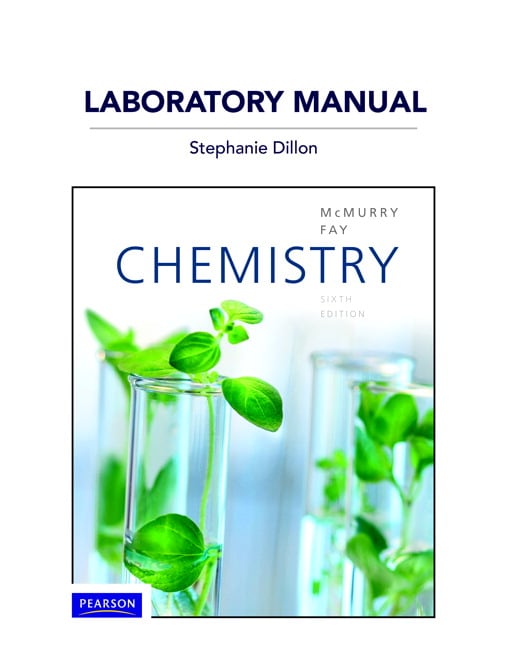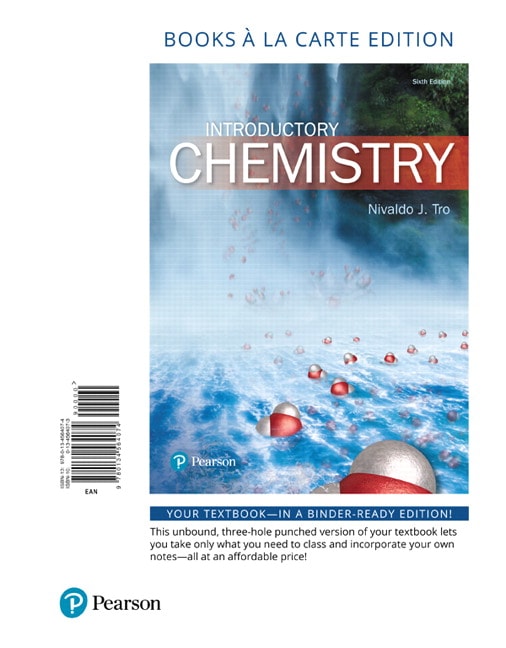Corwin Introductory Chemistry Lab Manual Complete
Within U.S.A. About this Item: Pearson, 2012. Condition: Used: Acceptable.MAY BE MISSING SOME LABORATORY PAGES. Book in 'Acceptable' condition. Will show clear signs of use with water damage to pages and worn, bent or torn covers.
2nd day shipping offered. Ships same or next day!!! Used books may not contain supplements such as access codes or CD's. We have the best customer service online!This is the U.S. Student edition as pictured unless otherwise stated. Seller Inventory # 3. From United Kingdom to U.S.A.
About this Item: Pearson Education (US), United States, 2018. Condition: New.
Language: English. Brand New Book. For lab courses in introductory, preparatory, and basic chemistry. Prepare introductory chemistry students for laboratory and provide a safe experience Emphasizing environmental considerations, Corwin s acclaimed Laboratory Manual for Introductory Chemistry offers a proven format of a pre-laboratory assignment, a stepwise procedure, and a post-laboratory assignment. More than 500,000 students to date in Introductory Chemistry, Preparatory Chemistry, and Allied Health Chemistry have used these experiments successfully. The 7th Edition continues to evolve with increased sensitivity to environmental and safety concerns in the laboratory. Recycle icons in the margin of each procedure alert students to recycle chemical waste and green chemical indicators remind students to use the appropriate waste containers provided to dispose of chemicals.
Corwin s lab manual can be packaged with any Pearson Intro Prep Chemistry book. Seller Inventory # AAS142 8. From United Kingdom to U.S.A. About this Item: Pearson Education (US), United States, 2012. Condition: New. Language: English. This book usually ship within 10-15 business days and we will endeavor to dispatch orders quicker than this where possible.
Brand New Book. Emphasizing environmental considerations, Corwin s acclaimed lab manual offers a proven format of a prelaboratory assignment, a stepwise procedure, and a postlaboratory assignment. More than 300,000 students to date in Introductory Chemistry, Preparatory Chemistry, and Allied Health Chemistry have used these bullet-proof experiments successfully. The Sixth Edition features a completely updated interior design, new environmental icons denoting green features, updated prelabs, and much more. Corwin s lab manual can be packaged with any Pearson Intro Prep Chemistry book. Seller Inventory # BTE945 9. From United Kingdom to U.S.A.
About this Item: Pearson Education (US), United States, 2018. Condition: New. Language: English. Brand New Book.
For lab courses in introductory, preparatory, and basic chemistry. Prepare introductory chemistry students for laboratory and provide a safe experience Emphasizing environmental considerations, Corwin s acclaimed Laboratory Manual for Introductory Chemistry offers a proven format of a pre-laboratory assignment, a stepwise procedure, and a post-laboratory assignment. More than 500,000 students to date in Introductory Chemistry, Preparatory Chemistry, and Allied Health Chemistry have used these experiments successfully. The 7th Edition continues to evolve with increased sensitivity to environmental and safety concerns in the laboratory. Recycle icons in the margin of each procedure alert students to recycle chemical waste and green chemical indicators remind students to use the appropriate waste containers provided to dispose of chemicals.
Corwin s lab manual can be packaged with any Pearson Intro Prep Chemistry book. Seller Inventory # AAS142 10.
Description For lab courses in introductory, preparatory, and basic chemistry. Prepare introductory chemistry students for laboratory and provide a safe experience Emphasizing environmental considerations, Corwin’s acclaimed Laboratory Manual for Introductory Chemistry offers a proven format of a pre-laboratory assignment, a stepwise procedure, and a post-laboratory assignment. More than 500,000 students to date in Introductory Chemistry, Preparatory Chemistry, and Allied Health Chemistry have used these experiments successfully. The 7th Edition continues to evolve with increased sensitivity to environmental and safety concerns in the laboratory.
Recycle icons in the margin of each procedure alert students to recycle chemical waste and “green chemical” indicators remind students to use the appropriate waste containers provided to dispose of chemicals. Corwin’s lab manual can be packaged with any Pearson Intro Prep Chemistry book. New - Environmental Icons alert students to recycle chemical waste. New - Instructor Demonstrations help reduce chemical waste. New - Experimental Procedures simplify tasks and provide a better workflow. A laboratory notebook (Appendix H) is included.
New - Pre-laboratory Assignments that help students prepare for an experiment have been added. New - Post-laboratory Assignments that synthesize the principles in an experiment are now included.
Each adoption of the laboratory manual includes a complementary Annotated Instructor’s Manual that contains the following for each experiment: suggested unknowns and directions for dispensing and preparing solutions, sample data tables, answers to post-laboratory assignments, and a Quiz Item File containing over 500 class-tested questions. A set of objectives helps students focus on experimental activities. A list of equipment and chemicals organizes the experimental materials. Discussions include example exercises to show students how to perform the calculations associated with each quantitative procedure.
Time-tested procedures and unknowns give good results, helping students build confidence and an appreciation for chemistry in the laboratory. Alerts to procedures that should be performed carefully and prelaboratory questions regarding safety are provided.
To ensure student safety, operations that present even minimal danger have been avoided. Environmentally “friendly” chemicals that do not contain lead, mercury, chromium, chloroform, or carbon tetrachloride are used. Line art illustrations demonstrate techniques for reading a metric ruler, graduated cylinder, thermometer, and buret; and instructions for using a laboratory burner, platform balance, beam balance, electronic balance, and volumetric pipet. Updated Prelaboratory Assignments that are detachable and can be submitted to the instructor before starting the experiment. Post-laboratory Assignments are also detachable and can be submitted to the instructor after finishing the experiment.
Check out the for a complete list of features and what's new in this edition. Table of Contents SAFETY PRECAUTIONS LOCKER INVENTORY WASTE DISPOSAL EXPERIMENTS 1 Introduction to Chemistry Topic: The Scientific Method A. Instructor Demonstrations B. Student Experiments 2 Instrumental Measurements Topic: The Metric System A. Length Measurement B.
Mass Measurement C. Mass and Volume of an unknown solid D. Volume Measurements E. Temperature Measurements 3 Density of Liquids and Solids Topic: Density A.
Instructor Demonstration-Density B. Density of Water C. Density of an Unknown Liquid D. Density of a Rubber Stopper E. Density of an Unknown Solid F. Thickness of Aluminum Foil 4 Freezing Point and Melting Points Topic: Change of Physical State A.

Cooling Curve and Freezing Point B. Melting Point of an Unknown 5 Physical Properties and Chemical Properties Topic: Physical and Chemical Properties A. Instructor Demonstrations B. Observation of Elements C.
Physical Properties D. Chemical Properties 6 “Atomic Fingerprints” Topic: Emission Spectra and Electron Energy Levels A.
Continuous Spectrum — White Light B. Line Spectrum — Hydrogen C. Line Spectra — Helium, Neon, Argon, Krypton, and Mercury D. Identifying Unknown Elements in a Fluorescent Light 7 Families of Elements Topic: The Periodic Table A. Analysis of Known Solutions B. Analysis of an Unknown Solution 8 Identifying Cations in Solution Topic: Qualitative Cation Analysis A. Analysis of a Known Cation Solution B.
Analysis of an Unknown Cation Solution 9 Identifying Anions in Solution Topic: Qualitative Anion Analysis A. Analysis of a Known Anion Solution B. Analysis of an Unknown Anion Solution 10 Analysis of a Penny Topic: Writing and Balancing Chemical Equations A.
Instructor Demonstrations-Combination Reactions B. Decomposition Reactions C. Single-Replacement Reactions D. Double-Replacement Reactions E. Neutralization Reactions F.

Percentages of Copper and Zinc in a Penny 11 Determination of Avogadro’s Number Topic: Avogadro’s Number and the Mole Concept A. Calibrating a Dropper Pipet B. Calculating Molecules in the Monolayer C. Determining Avogadro’s Number 12 Empirical Formulas of Compounds Topic: Empirical Formula A. Empirical Formula of Magnesium Oxide B.
Empirical Formula of Copper Sulfide 13 Analysis of Alum Topic: Percent Composition and Empirical Formula A. Percentage of Water in Alum Hydrate B. Percentage of Water in an Unknown Hydrate C.
Water of Crystallization in an Unknown Hydrate 14 Decomposing Baking Soda Topic: Mass—Mass Stoichiometry and Percent Yield A. Percent Yield of Na 2CO 3 from Baking Soda B. Percentage of NaHCO 3 in an Unknown Mixture 15 Precipitating Calcium Phosphate Topic: Mass—Mass Stoichiometry and Percent Yield A. Percent Yield of Ca 3(PO 4) 2 from CaCl 2 B. Percentage of CaCl 2 in an Unknown Mixture 16 Generating Hydrogen Gas Topic: Mass—Volume Stoichiometry and Combined Gas Law A.
Molar Volume of Hydrogen Gas B. Atomic Mass of an Unknown Metal 17 Generating Oxygen Gas Topic: Mass—Volume Stoichiometry and Combined Gas Law A. Percentage of KClO 3 in a Known Mixture B. Percentage of KClO 3 in an Unknown Mixture 18 Molecular Models and Chemical Bonds Topic: Structural and Electron Dot Formulas A. Molecular Models with Single Bonds B.
Molecular Models with Double Bonds C. Molecular Models with Triple Bonds D. Molecular Models with Two Double Bonds E. Unknown Molecular Models 19 Analysis of Saltwater Topic: Solubility and Solution Concentration A. Instructor Demonstration — Supersaturation B. Solutes and Solvents C. Rate of Dissolving D.

Concentration of Sodium Chloride in Saltwater 20 Analysis of Vinegar Topic: Acid—Base Titrations A. Preparation of Standard Sodium Hydroxide Solution B.
High School Chemistry Lab Manual
Concentration of Acetic Acid in Vinegar 21 Electrical Conductivity of Aqueous Solutions Topic: Net Ionic Equations A. Conductivity Testing–Evidence for Ions in Aqueous Solution B. Conductivity Testing–Evidence for a Chemical Reaction C. Net Ionic Equations–A Study Assignment 22 Activity Series of Metals Topic: Oxidation Numbers and Redox Reactions A. Oxidation Numbers of Iron B. Oxidation Numbers of Manganese C. Oxidation Numbers of Sulfur D.
Oxidation Numbers of Nitrogen E. Oxidation—Reduction Equations—A Study Assignment F. Activity Series and an Unknown Metal 23 Organic Models and Classes of Compounds Topic: Structural Formulas of Molecular Models A. Molecular Models of Hydrocarbons B. Molecular Models of Hydrocarbon Derivatives C. Unknown Molecular Models 24 Separation of Food Colors and Amino Acids Topic: Paper Chromatography A.
Chemistry Laboratory Manual
Separation of Food Colors by Paper Chromatography B. Identification of Amino Acids by Paper Chromatography 25 Laboratory Instruments and Technique Topic: Lab Final Exam A. Lab Practical Exam B.
Lab Written Exam APPENDICES A Laboratory Burner B Decigram Balance C Centigram Balance D Milligram Balance E Volumetric Pipet F Activity Series for Metals G Solubility Rules H Laboratory Notebook I Glossary J Answers to Prelaboratory Assignments.